Venezuelan bolívar
| Venezuelan bolívar | |
|---|---|
| Country: |
|
| Subdivision: | 100 céntimos |
| ISO 4217 code : | VES |
| Abbreviation: | Bs.S, also for short Bs. |
|
Exchange rate : (August 28, 2020) |
1 EUR = 5818 VES FOREX exchange rate May 8, 2019
|
The Venezuelan bolívar has been the national currency of the South American state of Venezuela since 1879 . It was named after Simón Bolívar . After a revaluation of the bolívar on January 1, 2008, it was called bolívar fuerte (Strong Bolivar; abbreviation: BsF ) to distinguish it from the old currency . On August 20, 2018, another currency cut was carried out at a ratio of 1: 100,000. For this purpose, the name Bolívar soberano was used to differentiate . However, the official currency denomination is still Bolívar for short ; the long names "Bolívar fuerte" and "Bolívar soberano" can not be found on coins or banknotes.
History and background
Bolívar (1879-2007)
In 1879 the Bolívar was officially introduced in Venezuela. It replaced the previously valid Venezolano in the ratio 1 Venezolano = 5 Bolívares. According to the principles of the Latin Union of Coins , which the Bolívar then followed, it was equivalent to 4.5 grams of fine silver . In 1887 the gold bolívar was introduced as the legal currency. In 1910 it became the sole means of payment.
In 1930 the gold standard was abandoned. In the period that followed, the bolívar was considered the most stable and internationally recognized currency in the region. This ended on February 18, 1983 with what later became known as Venezuela's Black Friday . Since then, the Bolívar has been in a process of constant devaluation . After an oil workers' strike in 2003, Hugo Chávez's government introduced capital controls. The bolívar could no longer be freely exchanged for other currencies such as the US dollar, whereupon unregulated trade between the US dollar and the bolívar developed.
Publication of the black market price of the bolívar against the dollar was made a criminal offense in 2007.
Bolívar fuerte (2008-2018)
On January 1st, 2008 the Bolívar got a new name: Bolívar Fuerte. Compared to the old nominal value, three zeros have been deleted. The exchange ratio was 1000 Bs to 1 BsF. During the exchange period of one year, both currencies were valid simultaneously in Venezuela. The existing fixed exchange rate to the US dollar , which has been in effect since 2005 , was retained and amounted to 2.15 BsF to 1 USD. The government's goal was to contain inflation and restore confidence in the currency.
With effect from January 11, 2010, the Venezuelan government had to undertake a further devaluation. Due to the consistently high inflation rate of 25 to 30 percent annually, the black market rate was too far removed from the official exchange rate. A two-part exchange rate was introduced: The cheaper rate of 2.60 BsF to 1 USD, which corresponds to a devaluation of 17 percent, has since been valid for "prioritized imports" such as food, for government authorities and so-called remesas , transfers from im Relatives living abroad to their dependents in Venezuela. However, the generally applicable exchange rate was devalued by 50 percent to 4.30 bolívares per dollar.
In the unregulated market, i.e. the black market, the exchange rate at that time was around 6.25 BsF per dollar. Many economists considered the devaluation to be overdue because the bolívar was extremely overrated. Venezuela's inflation was around 25 times that of the United States . More and more capital flowed into other currencies.
The devaluation allowed the Venezuelan government to reduce the budget deficit . The population reacted by buying hamsters. However, economists criticize the fact that the two-part exchange rate system in Latin America did not work in the 1980s. It opens up new avenues for corruption . It is very easy to withdraw money from the system via the various exchange rates. The Venezuelan opposition recalled Venezuela's Black Friday of 1983. At that time, a multi-level exchange rate system was also introduced, which Chavez described as "corrupt". At that time, $ 60 billion in capital flowed out.
On June 9, 2010, another parallel market, the so-called system for transactions in securities in foreign currency ( Sistema de Transacciones con Títulos en Moneda Extranjera - SITME) was introduced. Companies that cannot buy at the official exchange rate due to a lack of foreign currency can help themselves in this market with up to 50,000 US dollars a day.
On January 1, 2011, the Bolívar was again devalued. The favorable exchange rate for important goods such as food or medicines was canceled and adjusted to the general exchange rate of 4.30 bolívares per dollar, which meant a depreciation of 65 percent for these imported goods. The SITME course remained. In Venezuela, these goods are highly dependent on imports, so that a strong influence on consumer prices and thus on inflation is expected.
In February 2013, the Bolívar had to be devalued again sharply in view of the persistently high inflation. The new official exchange rate was now 6.30 bolívares per dollar. The main aim was to reduce domestic debts after the election year 2012 was characterized by excessive spending by the government of President Chávez, who died in March 2013. At the same time the exchange rate system for companies SITME was abolished. The black market exchange rate for the Bolívar to the US dollar at that time was around 20: 1. Instead of the SITME, the SICAD procedure ( Sistema Complementario de Administración de Divisas ) was introduced for foreign exchange management , which is designed as a second-price auction . At the first auction, which took place at the end of March 2013, it was learned from bidders that between 12 and 15 bolívares per dollar were being offered, i.e. a good double the official nominal price. Neither the exact course of the auctions nor the exchange rates were officially published.
Since the exchange of Venezuelan bolívares into convertible currencies is strictly regulated, a black market developed for this .
At the beginning of 2016, the exchange rate from Bolívar to dollars was 6.3 via CENCOEX, 1: 13.5 via SICAD 2, and 1: 200 via SIMADI. The black market rate was 1000 bolívar for $ 1. The current black market rate is published on the Internet by DolarToday , among others . In April 2016, inflation was estimated at around 320% for the current year due to the ongoing economic crisis, with the IMF assuming 720% just one month later.
While the collection of the - most recently largest - 100 bolívar note was already in progress, a new note worth 500 bolívar was issued from December 15, 2016, which represented a value of 0.14 US $ on the black market. Bolívar bills of 1,000, 2,000, 5,000, 10,000 and 20,000 (black market value US $ 5.6) were to follow in the following days. After the banks were unable to issue new banknotes in various cities, protests and looting took place on December 16 (local time), with three dead.
The 100 bolívar note was supposed to lose its validity in December 2016; after protests by the population in mid-December, the validity was extended to January 2, 2017. The extension of this period to January 20, 2017 was announced on December 30, 2016. Thereafter, shortly before the extension of the deadline, the validity of that banknote was successively extended to the 20th of the following month or the month after that. It is still valid to date (as of March 2018).
On May 31, 2017, the Bolívar was devalued according to the Sistema Complementario de Divisas (Dicom) by 64% to a rate of 2010 VEF for one US dollar. The black market rate at this point was already 6100: 1.
In February 2018, the government of Nicolás Maduros introduced the alleged " cryptocurrency " Petro as a parallel means of payment to the Bolívar Fuerte . There were no known transactions and the assumption was made that this generally implausible maneuver could have been a defense measure by the government against the spread of other cryptocurrencies in the country.
Bolívar soberano (since August 20, 2018)
Cash had almost completely disappeared from everyday life in the summer of 2018; Without a credit card it was almost impossible to trade. Business or purchases were carried out by means of transfer arrangements; the Venezuelans trusted in customers and service providers - a trust they no longer had in the currency. Taxi drivers demanded that the agreed fare be transferred before the start of the journey. The price of a roll of toilet paper was at times equivalent to a stack of banknotes at least four times the volume of the toilet roll.
In June 2018, following the announcement by President Maduro, another currency cut was to be carried out - the introduction was later postponed to August 4, 2018. The newly introduced Bolívar Soberano ("sovereign Bolívar", abbreviated: Bs.S) should replace the old "Bolívar fuerte" in a ratio of 1 to 1,000. For this purpose, new notes of 2, 5, 10, 20, 50, 100, 200 and 500 Bs.S as well as coins of 50 céntimos and 1 Bs.S should be issued. On July 6, 2018 (one month before the planned introduction), the largest banknote planned for issuance (500 Bs.S) already had a purchasing power of around 0.12 euros. On July 25, 2018, President Maduro announced another shift in the currency average. The introduction of the Bolívar soberano should start on August 20, 2018 and five zeros (instead of three as previously planned) should be deleted. For this purpose, the same banknotes should be imported that were originally intended for the 1: 1,000 currency average. The largest banknote of 500 Bs.S planned for introduction would have a purchasing power of just over 10 euros (as of the end of July 2018) or just under 5 euros (as of the end of August 2018).
On August 20, 2018, the currency average was 1: 100,000 with the transition to Bolívar soberano. The NZZ described the currency reform as "failed" after a week after the value of the new Bolivar soberano on the black market had lost forty percent against the dollar within a week. It was only after standing in line for hours that a journalist was able to withdraw the maximum amount of two five-bolivares. Banknotes and money paper became Venezuela's most important import goods.
In September 2018 the official exchange rate of the Bolívar soberano to the dollar was 60: 1, at the end of January it was 3300: 1 and until May 1st it was 5200: 1.
Coins and banknotes
Bolívar (1879-2007)
Coins
Bolívar fuerte (2008 to August 19, 2018)
Coins
After years of strong inflation, the coins of the Bolívar fuerte had become worthless and no longer played a role in monetary transactions. Here are the coins of the Bolívar:
| Face value | material | edge | Design front |
Design back |
Nickname | Front image |
Picture back |
|---|---|---|---|---|---|---|---|
| 1 céntimo | copper | smooth | Denomination of the coin, the eight stars and some waves that the stripes on the national flag represent | State coat of arms and issuing country | Céntavo |
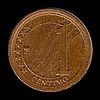
|
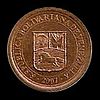
|
| 5 céntimos | copper | smooth | Denomination of the coin, the eight stars and some waves that represent the stripes on the national flag | State coat of arms and issuing country | Puya |

|
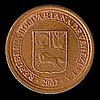
|
| 10 céntimos | nickel | smooth | Denomination of the coin, the eight stars and some waves that represent the stripes on the national flag | State coat of arms and issuing country | Mocha |
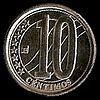
|

|
| 12½ centimos | nickel | smooth | Face value of the coin, the eight stars of the national flag and two palm trees | State coat of arms and issuing country | Locha |

|
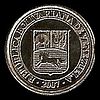
|
| 25 céntimos | nickel | smooth | Denomination of the coin, the eight stars and some waves that represent the stripes on the national flag | State coat of arms and issuing country | Medio |

|

|
| 50 céntimos | nickel | smooth | Denomination of the coin, the eight stars and some waves that represent the stripes on the national flag | State coat of arms and issuing country | real |

|
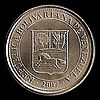
|
| 1 bolívar | Ring: brass, core: nickel |
smooth | Portrait of Simon Bolívar | Denomination of the coin, the eight stars, the national coat of arms and some waves representing the stripes on the national flag | Bolívar |
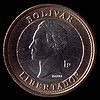
|
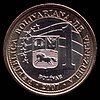
|
Banknotes
With the bolívar fuerte banknotes, the motifs are vertical on the front and horizontal on the reverse.
Series from 2008
The following Bolívar fuerte banknotes have all been in circulation since January 1st, 2008:
| Face value | image | colour | Front image | Picture back |
|---|---|---|---|---|
| 2 BsF | Francisco de Miranda | blue | ||
| 5 BsF | Pedro Camejo | orange | ||
| 10 BsF | Cacique Guaicaipuro | Orange and blue | ||
| 20 BsF | Luisa Cáceres de Arismendi | pink | ||
| 50 BsF | Simón Rodríguez | green | ||
| 100 BsF | Simón Bolívar | Brown and yellow |
Most recently, only the 100 notes of this series were in circulation. This was followed by the introduction of 500 notes and a short time later the other banknotes of a new series.
Series from 2016
The following Bolívar fuerte banknotes came into circulation in the first half of 2017:
| Face value | image | colour | Front image | Picture back |
|---|---|---|---|---|
| 500 BsF | Francisco de Miranda | Gray and light blue | ||
| 1000 BsF | Pedro Camejo | violet | ||
| 2000 BsF | Cacique Guaicaipuro | Orange and yellow | ||
| 5000 BsF | Luisa Cáceres de Arismendi | green | ||
| 10,000 BsF | Simón Rodríguez | Blue and yellow | ||
| 20,000 BsF | Simón Bolívar | Red and yellow |
Banknote from 2017
On November 1, 2017, President Nicolás Maduro announced the introduction of a 100,000 BsF banknote on November 2, 2017. The design of this banknote was almost identical to the old 100 BsF note, only the color is a little lighter yellow. Even the face value of the banknote is shown with the number “100” and not, as one might expect, with “100,000”. This is particularly problematic for foreign tourists who, due to the barely distinguishable banknotes, can easily become victims of fraud when changing or paying.
| Face value | image | colour | Front image | Picture back |
|---|---|---|---|---|
| 100,000 BsF | Simón Bolívar | Yellow and green |
Bolívar soberano (since August 20, 2018)
Coins
With the introduction of the Bolívar soberano, there are only two coins worth 50 céntimos and 1 bolívar.
| Face value | material | edge | Design front |
Design back |
Front image |
Picture back |
|---|---|---|---|---|---|---|
| 50 céntimos | Nickel-plated steel | Portrait of Simón Bolívar , the eight stars of the national flag | Denomination of the coin, national coat of arms , issuing country and some waves representing the stripes on the national flag |

|

|
|
| 1 bolívar | Ring: brass, core: copper-nickel |
Portrait of Simón Bolívar , the eight stars of the national flag | Denomination of the coin, national coat of arms , issuing country and some waves representing the stripes on the national flag |

|

|
Banknotes
Banknotes from 2018
With the introduction of the Bolívar soberano on August 20, 2018, a series of eight new banknotes was issued. The design of this series is very similar to that of the Bolívar fuerte series , but different colors, portraits and motifs are used. Since the currency is simply Bolívares even after the currency cut on August 20, 2018 , there is a risk, especially for foreign tourists, of receiving the worthless Bolívar Fuerte banknotes as change or change and of being cheated.
| Face value | image | colour | Front image | Picture back |
|---|---|---|---|---|
| 2 BsS | Josefa Camejo | Turquoise, olive green and brown | [1] | [2] |
| 5 BsS | José Félix Ribas | Blue, purple and orange | [3] | [4] |
| 10 BsS | Rafael Urdaneta | Orange, brown and red | [5] | [6] |
| 20 BsS | Simón Rodríguez | Light blue, blue purple and brown | [7] | [8th] |
| 50 BsS | Antonio José de Sucre | Orange, brown and purple | [9] | [10] |
| 100 BsS | Ezequiel Zamora | Orange, purple and green | [11] | [12] |
| 200 BsS | Francisco de Miranda | Light blue, brown and purple | [13] | [14] |
| 500 BsS | Simón Bolívar | Orange, dark brown and light brown | [15] | [16] |
| 50,000 BsS | Simón Bolívar | Orange, dark brown and light brown |
There are now new values of 10,000 and 20,000 bolivars.
Problem of exchange rate differences
Since the prices of goods and services are at the level of the black market exchange rate, but foreign visitors and tourists only legally have official exchange rates available, withdrawing cash and paying with credit cards is associated with high financial losses. When using credit cards, it is not possible to see the official exchange rate at which the card company is converting. Under certain circumstances, the somewhat cheaper DICOM rate is not even available, with a significant exchange rate loss of around 90% compared to the black market rate. In order to be able to offer the DICOM course, banks and card companies must take part in one of the difficult to apply for and carried out in a non-transparent procedure, officially called auction. Only a small part of the offers and inquiries have been met at these few appointments that have been made so far. In all other cases, the credit card companies must use the official exchange rate of 1 USD to 10 VEF. The exchange rate loss in this case is 99.995%, so 20,000 times the price is charged. Paying for a cup of coffee can be financially ruinous. The government and state bank, suffering from chronic currency shortages, use this questionable method to obtain currency in a cost-effective way.
Cash shortage
Due to the strong inflation and the ideologically justified refusal of the Venezuelan government to admit this fact and to issue larger banknotes, there was an extreme shortage of cash. The largest bank note in circulation at times (100,000 BsF) had a purchasing power of just 2 euro cents. For this reason, there was a need to make almost all payments by bank card or wire transfer. However, since the infrastructure for electronic payments is not available in rural areas, among other things, the need arose to store cash for this. From this a black market for banknotes developed. Due to the extreme difficulty and risk of procuring huge amounts (due to the low value) of banknotes, the banknote seller is paid up to five times the value as a transfer. The Venezuelan authorities consider these practices illegal and have launched the operation "manos de papel" (paper hands) for this purpose. Anyone who gets caught with a large amount of banknotes is liable to prosecution. In this case, the money is confiscated and the "offenders" face long prison terms. There were reports of the arrest of two people who had a combined sum of 100 million Bolívares in cash. The sum of money had a purchasing power equivalent to just under 25 euros.
Instead of the bolivar, producers without electronic transfer options relied more than ever on barter in 2019 , which became the norm in rural areas in times of hyperinflation.
The bolivar had already disappeared from everyday life in 2018, except for purchases from state companies such as gasoline, electricity or gas. The livelihoods of many Venezuelans were the remittances of Venezuelans living abroad. Due to the ban on freely convertible currencies by the Chavismus, there was a greater spread of crypto currencies, especially Dash .
Web links
- Venezuelan Central Bank website (Spanish).
- Official website of the central bank for currency conversion (Spanish).
- Currency Conversion Act (Spanish; PDF; 25 kB).
- Dólar paralelo - Black market exchange rate Bolívar Fuerte against the US dollar (Spanish).
- VENEZUELA - Banco Central de Venezuela. In: Bank Note Museum. (English, historical overview of the bolívar banknotes).
- [17] All Venezuelan banknotes
Individual evidence
- ↑ a b c d DolarToday. In: DolarToday. Retrieved October 31, 2019 (Spanish).
- ↑ a b c Bolivar devaluation: Chávez sends Venezuela back to the 80s ( Memento from January 14, 2010 in the Internet Archive ) , ftd.de from January 11, 2010
- ↑ Venezuela prohíbe dólar paralelo , CNN Extensión, December 14, 2007.
- ↑ n-tv.de: “Strong Bolivar” in Venezuela from October 2, 2007.
- ↑ BBC: Venezuela wants slash value of currency from January 9, 2010.
- ↑ a b c How Chavez is running down Venezuela ( memento from January 18, 2010 in the Internet Archive ) , ftd.de from January 15, 2010
- ↑ Devaluation of the Venezuelan currency to 4.30 VEF per US dollar: lower exchange rate for food and medication abolished ( memento of the original from April 21, 2012 in the Internet Archive ) Info: The archive link was automatically inserted and not yet checked. Please check the original and archive link according to the instructions and then remove this notice. , Austrian Chamber of Commerce from January 3, 2011.
- ↑ Venezuela Central Bank Said to Boost Sitme Bond Sales ( December 18, 2010 memento in the Internet Archive ) , Bloomberg.com, December 14, 2010
- ↑ struggle for economic growth: Venezuela evaluates currency from , n-tv .com December 30 of 2010.
- ↑ dpa: Venezuela's currency devaluation causes concern. In: handelsblatt.com . February 16, 2013, accessed January 2, 2017 .
- ↑ Venezuela depreciates heavily , Deutsche Welle dated February 9, 2013.
- ^ Jan Ulrich: Venezuela reformed foreign exchange trading , amerika21.de of March 25, 2013.
- ↑ Dólar en primera subasta Sicad está duplicando el precio Cadivi , El Mundo (Venezuela) of March 26, 2013.
- ↑ Klaus Ehringfeld: economic crisis in Venezuela: A state shuts down. In: Spiegel Online . April 30, 2016, accessed January 2, 2017 .
- ↑ Emergency in Venezuela: Coca-Cola stops production due to a lack of sugar. In: Spiegel Online . May 24, 2016, accessed January 2, 2017 .
- ↑ Hyperinflation: Venezuela introduces larger banknotes orf.at, December 14, 2016, last accessed December 30, 2016.
- ↑ Chaos and protests in Venezuela: three dead in protests orf.at, December 17, 2016, accessed December 17, 2016.
- ↑ Venezuela: 100 Bolivar note remains in circulation longer orf.at, December 30, 2016, accessed December 30, 2016.
- ↑ Venezuela depreciates currency drastically. In: The Standard. June 1, 2017, accessed June 1, 2017 .
- ↑ a b Bolivar does not beat Bitcoin , Novaya Gazeta, March 25, 2018 (Russian); "The subject of cryptocurrency would never have become topical in Venezuela if the authorities had not forbidden citizens to use freely convertible money."
- ↑ Special Report: In Venezuela, new cryptocurrency is nowhere to be found , Reuters, August 30, 2018
- ↑ How does a country work without a functioning currency? An experience report from Venezuela , NZZ , October 12, 2018
- ↑ Venezuela introduces new currency in August. In: Frankfurter Allgemeine. June 2, 2018, accessed July 3, 2018 .
- ↑ Venezuela: precios comenzarán a expresarse en 'bolívares soberanos' a partir del 1º de mayo. In: El Nuevo Herald . March 27, 2018, Retrieved April 8, 2018 (Spanish).
- ↑ With 1,000,000% inflation, Venezuela is slashing five zeroes from its currency. In: Quartz Media LLC. July 26, 2018, accessed July 27, 2018 .
- ↑ Venezuela wants to resolve the economic crisis with reforms. In: Salzburger Nachrichten. August 20, 2018. Retrieved August 20, 2018 .
- ↑ Venezuela's currency reform failed , NZZ, August 27, 2018, page 20; Quote Maduro: he found a "magic formula"; "Believe me, the plan will work".
- ↑ a b Heterodox and Orthodox Economics in Venezuela: A Conversation with Luis Salas (Part I) , venezuelanalysis.com, April 26, 2019
- ↑ Le Venezuela double le salaire minimum , swissinfo, April 27, 2019 (French)
- ↑ Hyperinflation: Venezuela prints 100,000 bolivar note orf.at, November 2, 2017, accessed November 2, 2017.
- ↑ Beate Macura: Vacationers paid 1,400 euros for snacks and coffee. In: help.ORF.at. May 20, 2017. Retrieved April 10, 2018 .
- ↑ Detienen a dos ciudadanos por cargar 100 millones de bolívares en efectivo. In: Globovision. June 4, 2018, Retrieved July 28, 2018 (Spanish).
- ↑ Crisis en Venezuela: cómo funcionan los mercados del trueque en el país , BBC, April 15, 2019
- ↑ Venezuela Economic Report 2017/18 , Federal Department of Foreign Affairs , June 30, 2018





















